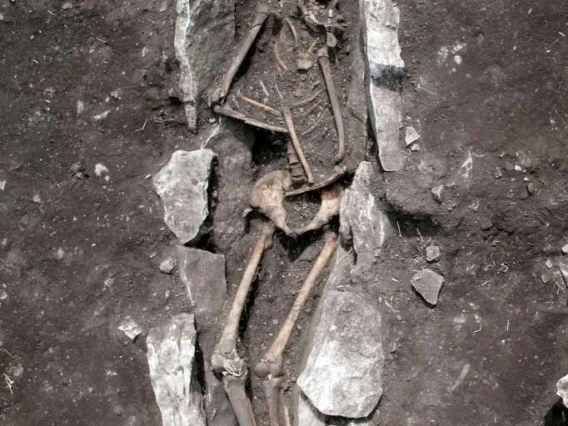
During the summer of 2016, University of Arizona Classics faculty and graduate students, along with other archeologists on their international team, excavated human bones at a sacrificial altar to Zeus on Mount Lykaion in Greece. The team believes the bones are those of an adolescent male, and the evidence suggests they may date to the 11th century BC. The rare discovery was reported around the world, including coverage in the New York Times, the Washington Post, the Guardian, the International Business Times, the Smithsonian, and the American School of Classical Studies at Athens.
The co-directors of the Mt. Lykaion Excavation and Survey Project are University of Arizona faculty Dr. Mary Voyatzis, Professor of Anthropology and Classics, and Dr. David Gilman Romano, Nicholas and Athena Karabots Professor of Greek Archaeology in Anthropology and Associate Faculty in Classics, along with the Hellenic Ministry of Culture & Sports’ Dr. Anna Karapanagiotou, Director of the Ephoreia of Antiquities of Arcadia in Greece.
On October 12 at 5:30pm, Dr. Romano and Dr. Voyatzis will discuss this amazing discovery on a panel at the UA Poetry Center. UA Classics faculty Dr. Arum Park and Dr. Courtney Friesen will join the panel’s discussion regarding relevant ancient literary texts, including sources from the Judeo Christian tradition, that may shed light on this discovery. More information can be found here.
University of Arizona students participating in the excavation included Classics M.A. students Stephen Czujko, Travis Hill, Elizabeth Keyser, Kelly Moss, and Clare Rasmussen, as well as Anthropology Ph.D. students Stephanie Martin and Jay Stephens, Architecture major Audrey Gusick, and Civil Engineering major Alex Weber. UA Classics alumni Lauren Alberti, Lauren Dreyfuss, Natalie Gleason, John Keck, Matt Pihokker, and Billie Rolla also were involved in the excavation.
The excavation team included University of Arizona Regents Professor of Geology Emeritus and Provost Emeritus George Davis and Thomas Keating, former chair of the UA Foundation Board of Directors.
Dr. Romano was quoted in several news outlets, including the New York Times article and the Washington Post article:
“‘Several ancient literary sources mention rumors that human sacrifice took place at the altar, but up until a few weeks ago there has been no trace whatsoever of human bones discovered at the site,’ said excavator David Gilman Romano, professor of Greek archaeology at the University of Arizona.”
“‘Whether it’s a sacrifice or not, this is a sacrificial altar ... so it’s not a place where you would bury an individual. It’s not a cemetery,’ excavator David Gilman Romano, professor of Greek archaeology at the University of Arizona, told the Associated Press.”
The Mt. Lykaion Excavation and Survey Project raises funds for each student selected to work on the project, covering their room, board, and travel to Greece. Many of the UA students involved in the project were the recipients of the Mt. Lykaion Excavation and Survey Project’s Arcadian Scholarships. Students and the project overall also received major funding from the Frelinghuysen Foundation, the Hellenic Cultural Foundation, the Institute for Aegean Prehistory (INSTAP), the National Geographic Society, the Parrhasian Heritage Foundation, and numerous private donors, including Arch and Laura Brown, Jeannie and Cole Davis, Betty Edmonson, Adaline Frelinghuysen and Bea Van Roijen, Nicholas and Athena Karabots, Tom and Reenie Keating, Brian Kelly, Annette Merle-Smith, Patricia Morgan and Peter Salomon, Jim Ottaway, Angel Voyatzis, as well as many other local and out of town donors.
(Photo Credit: Titus Frelinghuysen. Source: Hellenic Culture Ministry)

